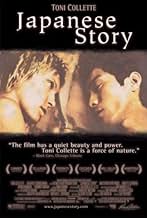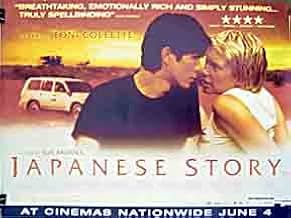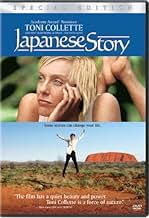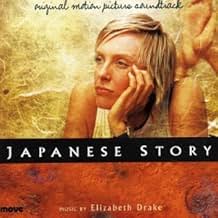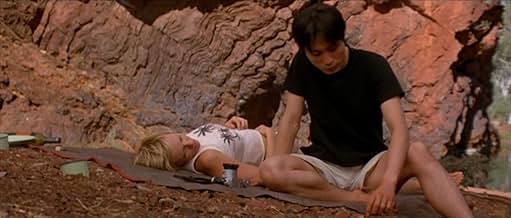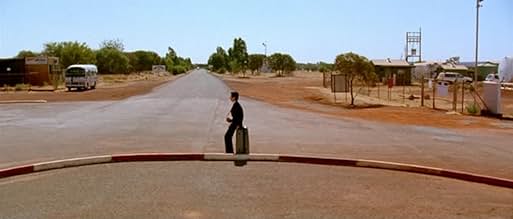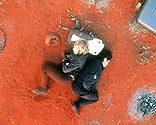VALUTAZIONE IMDb
6,8/10
6913
LA TUA VALUTAZIONE
Un geologo e un giapponese che trova fastidioso rimangono bloccati nel deserto di Pilbara: una delle regioni più remote della Terra.Un geologo e un giapponese che trova fastidioso rimangono bloccati nel deserto di Pilbara: una delle regioni più remote della Terra.Un geologo e un giapponese che trova fastidioso rimangono bloccati nel deserto di Pilbara: una delle regioni più remote della Terra.
- Regia
- Sceneggiatura
- Star
- Premi
- 20 vittorie e 13 candidature totali
Jules Hutchinson
- Canteen Worker
- (as Jules Hutchison)
Recensioni in evidenza
Australia has given the cinema some wonderfully adept and strikingly effective female actors in the past twenty years or so, Judy Davis starting a parade that includes Nicole Kidman, Cate Blanchett and Toni Collett among others. Collett has the ability to convincingly inhabit many different roles, her part as the depressed, suicidal mom in "About a Boy" being one of her most memorable.
"Japanese Story" is a quirky tale about Sandy Edwards, Collette, an Australian geologist in her, I would guess, mid-thirties. She's ordered to squire about the son of a Japanese industrialist whose investment in a major project is dearly desired by her bosses. The young man, handicapped by a very poor grasp of English and virtually none of Australian, is played by Gotaro Tsunashima. He might be well known in his native country but he was a new screen presence for me.
Sandy takes him on a tour of an achingly eerie, desolate, windswept part of Western Australia. Must of the movie was filmed in the Pilbara Desert, still aborigine country.
Sandy and her charge encounter adventurous situations while, no surprise, a romance springs up. Why Sandy would be attracted to the younger gentleman is never explained and it really shouldn't have been. "Japanese Story" asks the viewer to simply accept that liaisons arise without any deep preliminary exposition of character.
I won't reveal the plot, somewhat unexpected, but fate insures that this affair doesn't proceed swimmingly. What makes the movie is Collette's superb and affecting acting. I cared about her while knowing relatively little about her character's past life other than she hasn't completely resolved mom-daughter issues.
Nothing in this film could impel me to ever wish to go to the Pilbara Desert but it does excite my desire to see Collette take on many more challenging roles. She has a strong future-I hope.
8/10. See it if it plays near you, rent it later if not. You won't be sorry.
"Japanese Story" is a quirky tale about Sandy Edwards, Collette, an Australian geologist in her, I would guess, mid-thirties. She's ordered to squire about the son of a Japanese industrialist whose investment in a major project is dearly desired by her bosses. The young man, handicapped by a very poor grasp of English and virtually none of Australian, is played by Gotaro Tsunashima. He might be well known in his native country but he was a new screen presence for me.
Sandy takes him on a tour of an achingly eerie, desolate, windswept part of Western Australia. Must of the movie was filmed in the Pilbara Desert, still aborigine country.
Sandy and her charge encounter adventurous situations while, no surprise, a romance springs up. Why Sandy would be attracted to the younger gentleman is never explained and it really shouldn't have been. "Japanese Story" asks the viewer to simply accept that liaisons arise without any deep preliminary exposition of character.
I won't reveal the plot, somewhat unexpected, but fate insures that this affair doesn't proceed swimmingly. What makes the movie is Collette's superb and affecting acting. I cared about her while knowing relatively little about her character's past life other than she hasn't completely resolved mom-daughter issues.
Nothing in this film could impel me to ever wish to go to the Pilbara Desert but it does excite my desire to see Collette take on many more challenging roles. She has a strong future-I hope.
8/10. See it if it plays near you, rent it later if not. You won't be sorry.
"Japanese Story" is a fascinating exploration of gender and cultural roles, with a more incisive take on the contrasts than "Lost in Translation," let alone than in the simplicity of "The Last Samurai."
The Australian outback is a harsher but beautiful landscape of blokes and sheilas than the Manhattan of "Sex and the City" but it brings into relief similar questions of expectations of guys and gals in life and sex.
Toni Colette's "Sandy" is one tough geologist required to guide Gotaro Tsunashima to his father's company's environment-destroying mining businesses. Each suspiciously views the other through narrow stereotypical lenses that block out the complexities of their real lives and potential.
They very gradually adapt to each other, opening each other up to new experiences in quite unexpected ways, even though their language and life communication is still limited. She is the shaggy, physical, confident one; he is the smooth, intellectual, diffident one. "Sandy" is aggressive in a way much more typical of males in U.S. movies, while "Tachibana" is redolent of the farm wife in "The Bridges of Madison County."
The third act is even more startling in its catharsis for "Sandy" as she finds inner strengths and vulnerabilities to deal with her responsibilities across the cultural chasm.
The Australian outback is a harsher but beautiful landscape of blokes and sheilas than the Manhattan of "Sex and the City" but it brings into relief similar questions of expectations of guys and gals in life and sex.
Toni Colette's "Sandy" is one tough geologist required to guide Gotaro Tsunashima to his father's company's environment-destroying mining businesses. Each suspiciously views the other through narrow stereotypical lenses that block out the complexities of their real lives and potential.
They very gradually adapt to each other, opening each other up to new experiences in quite unexpected ways, even though their language and life communication is still limited. She is the shaggy, physical, confident one; he is the smooth, intellectual, diffident one. "Sandy" is aggressive in a way much more typical of males in U.S. movies, while "Tachibana" is redolent of the farm wife in "The Bridges of Madison County."
The third act is even more startling in its catharsis for "Sandy" as she finds inner strengths and vulnerabilities to deal with her responsibilities across the cultural chasm.
This is as much an Australian story as a Japanese one. We are not about to turn Japanese, but our close economic relationship over the last 50 years has to some extent transcended the cultural gap that divides us, and the bitterness of World War 2. On one level, this is a very personal story of two people from different cultures who become closer than they might have imagined. On another level it examines two very different cultures tied together by economic necessity. These themes are played out in a truly awe- inspiring ancient landscape, which, as others have remarked, is a character on its own.
I've not been to the Pilbara, but I've been to places like it elsewhere in Australia, and they tend to have the effect of reminding you of the fragility of your existence. The Aborigines (represented here by only a gas station attendant) regarded themselves as belonging to the land and here you can see why. It's not clear what Tachibana Hiromitsu, the rich businessman's son, is looking for in the desert, but he certainly feels its power. Just why Sandy the tough female geologist comes to harbour tender feelings towards him is not evident either; perhaps it's the mothering instinct at work- he's not an adaptable kind of guy and perhaps she senses his vulnerability.
Apart from the firm refusal to turn this film into a romantic comedy, despite some `When Harry Met Sally' moments, there are several other things going for it. First there is Toni Collette's entirely convincing performance which overcomes some weaknesses in the storyline (and improbabilities in her character). She has a lot of ground to cover, from boredom to hilarity, from dislike to intimacy, and from terror to melancholy.
Second, the cinematography fully exploits the scenery without detracting from the story. Much of `Japanese Story' was filmed around Port Headland in the Pilbara, but it's not a tourist brochure. Third, even the minor parts are played with precision (eg John Howard as the BHP man and Yukimo Tanaka as Tachibana's wife). It's difficult to judge just how effective Gotaro Tsunashima is you'd need to be Japanese, I guess, and anyway the script is from an Australian, Alison Tilson. To my eyes he seems real enough, if we accept he's from a very privileged and sheltered background. It's interesting that Sandy seems to be the initiator of their intimacy (he doesn't resist!).
I think this film would hold up well anywhere. It has more than the usual emotional content for an Australian film, an intriguing and poignant story, good acting, and it's not too long. The admission price is also considerably cheaper than an air ticket to Port Headland.
I've not been to the Pilbara, but I've been to places like it elsewhere in Australia, and they tend to have the effect of reminding you of the fragility of your existence. The Aborigines (represented here by only a gas station attendant) regarded themselves as belonging to the land and here you can see why. It's not clear what Tachibana Hiromitsu, the rich businessman's son, is looking for in the desert, but he certainly feels its power. Just why Sandy the tough female geologist comes to harbour tender feelings towards him is not evident either; perhaps it's the mothering instinct at work- he's not an adaptable kind of guy and perhaps she senses his vulnerability.
Apart from the firm refusal to turn this film into a romantic comedy, despite some `When Harry Met Sally' moments, there are several other things going for it. First there is Toni Collette's entirely convincing performance which overcomes some weaknesses in the storyline (and improbabilities in her character). She has a lot of ground to cover, from boredom to hilarity, from dislike to intimacy, and from terror to melancholy.
Second, the cinematography fully exploits the scenery without detracting from the story. Much of `Japanese Story' was filmed around Port Headland in the Pilbara, but it's not a tourist brochure. Third, even the minor parts are played with precision (eg John Howard as the BHP man and Yukimo Tanaka as Tachibana's wife). It's difficult to judge just how effective Gotaro Tsunashima is you'd need to be Japanese, I guess, and anyway the script is from an Australian, Alison Tilson. To my eyes he seems real enough, if we accept he's from a very privileged and sheltered background. It's interesting that Sandy seems to be the initiator of their intimacy (he doesn't resist!).
I think this film would hold up well anywhere. It has more than the usual emotional content for an Australian film, an intriguing and poignant story, good acting, and it's not too long. The admission price is also considerably cheaper than an air ticket to Port Headland.
8=G=
It would be impossible to say anything substantially meaningful about "Japanese Story" without spoiling the film for those who have not seen it. Suffice it to say, it's set in Australia and works with a an Aussie woman (Colette) and a Japanese man (Hiromitsu) to build slowly to an emotionally potent situation - a series of moments - and then lingers in the denouement allowing the audience to savor the emotions evoked. For some, those feelings may be nil. For others they may be powerful and overwhelming. Personally, I wept. Objectively, the film, about a woman by women, is well crafted and Colette's performance is outstanding. The film deserves high marks in all aspects from cinematography to music to casting, etc. However, when the closing credits roll, your experience will have been as unique as yourself. And whatever that experience is, it will be less if you know the outcome in advance. (B+)
I don't know what to expect when I went to see "Japanese Story" - I didn't read any review other than hearing Toni Collette did a terrific job and the trailer is interesting. I sensed that the element of 'death' could be part of the theme/plot as I noted at a beginning scene where Sandy (Collette's character) was sitting down reading papers in her Mum's kitchen and her Mum casually remarked that death is part of life. A brief notion and director Sue Brooks continues on letting us follow Sandy around: at her office, we see her modern geological double-monitor workstation; we hear her frustrated exchange with male business partner on 'dumping' her the task of handling business client arriving from Japan. We follow her home still vexed at the agonizing thought of accompanying a Japanese client - meanwhile we're shown how matter of fact she goes about getting her chow down, with new age gadgets like a self-rotating can opener. The screen cuts to a small airfield. We see an Oriental man (Gotaro Tsunashima) in suits steps off a plane. The air about him is detached. The contrast is felt when Collette arrives in a hurry, disheveled appearance and in casual slacks. So the journey of this odd pair begins. A fascinating one at that.
It may not be apparent immediately that you'd be experiencing an emotional ride. But I found the pace just right - right there in the outback environment with the two of them, day, night, very hot, shivering cold, sweating, digging. There's a certain atmosphere to the film - can't quite label it but definitely Australian geographical-oriented - land, nature and people. Thrown into the mix is the Japanese culture for added spice, thoughtfully put together. Hence the joy, jumping for joy, laughter, joking, gentleness, intimacy, we'd understand. The turn of events edifies how unexpected life can be - the yin and yang, the ecstasy and sadness, just at the change of a moment, a motion stunned, numb. The mystery of life and death is utterly incomprehensible by man. The focus is not on grief or state of shock, nor simply on cultural differences, the aim seems further: it almost culminates in the words about the joy given to him, the chance to appreciate the vastness of the space (desert), and being able to open his heart.
The two Japanese roles were well cast: Gotaro Tsunashima as Hiro performed pitch perfect. The role of the wife by Yumiko Tanaka, though brief, is important to complement Collette's role. Both gave just the right dose and tempo to the characters.
The Australian landscape is simple yet breathtaking. Cinematographer Ian Baker and film editor Jill Bicock are both from Australia and had worked together on "IQ" 1994 and "A Cry in the Dark" 1988. Music by Elizabeth Drake and casting by Dina Mann both are former collaborators with the team of Brooks, Tilson and producer Sue Maslin in 1997 ("Road to Nhill").
The film reminds me of w-d Friðriksson's "Cold Fever" (1995) and w-d Clara Law's "The Goddess of 1967" (2000). The former is a road movie of a young Japanese businessman traveling to Iceland to observe tradition and honor his dead parents; the latter is an Australian made film with outback landscapes and an intriguing non-conforming story.
Kudos to Alison Tilson who has written an insightful script, and Sue Brooks who has confidently directed this film made in "forty days and forty nights in the desert." Production by Gecko Films, Australia, and distribution by Samuel Goldwyn Films, U.S., "Japanese Story" is a thought-provoking film to experience.
It may not be apparent immediately that you'd be experiencing an emotional ride. But I found the pace just right - right there in the outback environment with the two of them, day, night, very hot, shivering cold, sweating, digging. There's a certain atmosphere to the film - can't quite label it but definitely Australian geographical-oriented - land, nature and people. Thrown into the mix is the Japanese culture for added spice, thoughtfully put together. Hence the joy, jumping for joy, laughter, joking, gentleness, intimacy, we'd understand. The turn of events edifies how unexpected life can be - the yin and yang, the ecstasy and sadness, just at the change of a moment, a motion stunned, numb. The mystery of life and death is utterly incomprehensible by man. The focus is not on grief or state of shock, nor simply on cultural differences, the aim seems further: it almost culminates in the words about the joy given to him, the chance to appreciate the vastness of the space (desert), and being able to open his heart.
The two Japanese roles were well cast: Gotaro Tsunashima as Hiro performed pitch perfect. The role of the wife by Yumiko Tanaka, though brief, is important to complement Collette's role. Both gave just the right dose and tempo to the characters.
The Australian landscape is simple yet breathtaking. Cinematographer Ian Baker and film editor Jill Bicock are both from Australia and had worked together on "IQ" 1994 and "A Cry in the Dark" 1988. Music by Elizabeth Drake and casting by Dina Mann both are former collaborators with the team of Brooks, Tilson and producer Sue Maslin in 1997 ("Road to Nhill").
The film reminds me of w-d Friðriksson's "Cold Fever" (1995) and w-d Clara Law's "The Goddess of 1967" (2000). The former is a road movie of a young Japanese businessman traveling to Iceland to observe tradition and honor his dead parents; the latter is an Australian made film with outback landscapes and an intriguing non-conforming story.
Kudos to Alison Tilson who has written an insightful script, and Sue Brooks who has confidently directed this film made in "forty days and forty nights in the desert." Production by Gecko Films, Australia, and distribution by Samuel Goldwyn Films, U.S., "Japanese Story" is a thought-provoking film to experience.
Lo sapevi?
- BlooperWhen the QANTAS jet to Kyoto leaves, it is actually leaving from the Perth domestic airport. The international terminal, where it would really leave from, and the Darling Ranges to the east, are clearly visible in the background.
- Curiosità sui creditiOur thanks to the people of Nyamal, Ngarluma, Yinjibarndi, Bunjima and Nyiparli Nations.
- ConnessioniFeatured in Inside Japanese Story: an evening with the film-makers (2004)
- Colonne sonoreABC News Theme
(1986)
Written by Tony Ansell (as T. Ansell) and Peter Wall (as P. Wall)
Published by ABC Music Publishing and
Kindly reproduced with the permission of the Australian Broadcasting Corporation
I più visti
Accedi per valutare e creare un elenco di titoli salvati per ottenere consigli personalizzati
- How long is Japanese Story?Powered by Alexa
Dettagli
- Data di uscita
- Paese di origine
- Siti ufficiali
- Lingue
- Celebre anche come
- Японская история
- Luoghi delle riprese
- Aziende produttrici
- Vedi altri crediti dell’azienda su IMDbPro
Botteghino
- Budget
- 5.740.000 USD (previsto)
- Lordo Stati Uniti e Canada
- 647.054 USD
- Fine settimana di apertura Stati Uniti e Canada
- 23.962 USD
- 4 gen 2004
- Lordo in tutto il mondo
- 4.098.613 USD
- Tempo di esecuzione
- 1h 46min(106 min)
- Colore
- Mix di suoni
- Proporzioni
- 2.35 : 1
Contribuisci a questa pagina
Suggerisci una modifica o aggiungi i contenuti mancanti







